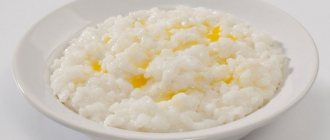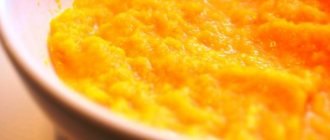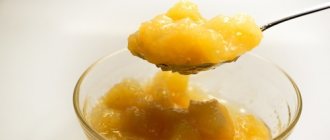Milk-based porridge is a mandatory dish on the children's menu. They help improve immunity, give the baby strength and energy, and saturate the child’s body with microelements necessary for its full development. Parents can prepare milk porridge for children under one year of age themselves, or they can buy it in pharmacies or in special departments of stores. Before you start such complementary feeding, you need to know when and how you can introduce milk porridge into your baby’s diet while breastfeeding.
Tips for moms before feeding a new food for the first time
- Introduce porridge into complementary foods slowly. Give your baby 1-2 spoons in the morning before feeding with formula or mother's milk (if breastfeeding).
- After breakfast, offer the baby to drink water or supplement with breastfeeding/milk formula.
- Start feeding porridge with 0.5 teaspoon, daily increasing the dose by 2 times (if there are no reactions).
- The optimal period of adaptation to new food is 10 days. During this period of time, the child will get used to the new dish. Then you can increase the single dose to 150 grams.
- How much butter should I add to one serving? The rules dictate that mothers do this only 3 weeks after the introduction of the porridge began! Start with 1 gram, increasing to 5 grams by 8 months of age.
- If your baby is reluctant to try food, you can change the order and give him a little a few times a day.
- Start introducing a new diet with dairy-free varieties. Then you can dilute them with mixture or baby milk. Cooking a healthy breakfast from cow's milk is not advisable in the first year of a baby's life.
- Monitor your child's reaction to new food. In case of stomach upset or allergies, you should immediately exclude the selected porridge from your diet.
QUOTE: To protect your baby from intestinal and skin disorders, you need to keep a food diary. Write down a diagram in it with the date, quantity, time of food intake, the appearance or absence of reactions in the child. If a rash appears on the baby’s body, you need to stop introducing the new ingredient and give an anti-allergy drug. If there is swelling of the face, spots on the body and shortness of breath, you need to call a doctor.
Which porridge should I give first?
Not all cereals are suitable for your first introduction to this dish. Some contain gluten, while others take longer to digest in the intestines. Our table will help you understand the question of how to administer it correctly, as well as the sequence of administration, dosage and features of each cereal.
Table “How to introduce complementary feeding to an infant”
| Recommended age for starting complementary feeding | Groats | Main characteristics | Maximum serving size |
| 6–7 months | Buckwheat | Despite its low calorie content, buckwheat is rich in iron, magnesium, protein, vitamins B1 and B2, and fiber. This breakfast helps digestion. Does not cause allergies, can be included in the first complementary foods. | 170 ml |
| Rice | Hypoallergenic cereal. Children with loose stools should prepare rice porridge. Normalizes intestinal flora, contains a small amount of vegetable protein. Digests quickly and without problems. | 170 ml | |
| Corn | It contains a lot of fiber and also helps fight constipation. Corn is an excellent option for expanding complementary feeding with cereals. | 170 ml | |
| 8 months | Oatmeal | One of the most popular and element-rich cereals. Saturated with proteins and fiber, which promotes active growth of muscles and bones. Normalizes the functioning of the digestive system. | 180 ml |
| 9–10 months | Millet | It contains iron, magnesium, phosphorus, fiber, etc. Many children love this breakfast. | 190 ml |
| After 1 year | Manna | Highly nutritious cereal. Saturates the body and keeps you feeling full for a long time. It contains gluten, so it is recommended to give it to the baby with caution and infrequently (up to 2 times a week). | 200 ml |
How to cook
Many mothers do not trust factory production and prefer to prepare baby food at home. But do-it-yourself porridge for first feeding is not always safe. Sometimes, even when breastfeeding, a baby may experience upset and allergies. What is the reason? There may be several reasons. How to prepare porridge for the first feeding? We prepare it ourselves, taking into account the principles of preparing the first breakfast:
- How to cook porridge for the first feeding? Before adding cereal to water, it must be ground into flour. This can be done in a coffee grinder. It is recommended to grind the cereal before each preparation.
- Prepare porridge for the first feeding with your own hands only in water! The first porridge should be dairy-free. Then you can dilute the already prepared breakfast with formula milk, for a baby with mother’s milk or baby milk (which is given out at the dairy kitchen).
- The diluted and cooked cereal should be liquid, with a consistency similar to fatty kefir. Approximate dosage: 5–7 grams per 100 ml of liquid.
- You need to cook the cereal for about 5 minutes, then the porridge for complementary feeding should be cooled to 35–37 degrees.
- How to cook rice porridge? This cereal needs to be kept in boiling water longer: about 7 minutes. Before cooking rice porridge, be sure to grind it in a coffee maker until it becomes flour.
- After a week of getting to know a new food, you can add a drop of butter to your breakfast recipe.
Which porridge to start complementary feeding with?
The first complementary feeding starts with gluten-free porridges in water. Formula-fed babies begin to be given adult food from four months, and porridge for babies is given from six months. The most optimal is buckwheat, which is characterized by hypoallergenicity and easy digestibility. It is rich in iron, magnesium, phosphorus and B vitamins.
A week later, rice porridge is introduced, and after another week, corn porridge is introduced. These cereals do not contain gluten, are easily digestible and rarely cause allergies. If complementary feeding is successful, gluten grains are started. They are more difficult to digest and can cause allergies, but they effectively cleanse the body and remove toxins, strengthen the immune system, have a positive effect on the functioning of internal organs, and promote the full development and proper growth of the baby.
Among gluten grains, oatmeal is first included, then wheat, barley and, after 11-12 months, semolina are given. Semolina porridge is considered the most useless and dangerous porridge, as it often causes allergies and leads to excess weight. However, if the baby is underweight, it will effectively help the baby.
Pediatricians recommend introducing porridge with milk after a year, when the baby has mastered all grains. However, if the child tolerates water meals well, you can try introducing the meal at 10-11 months, for artificial babies - at 9 months.
Types of first porridges
There is a large selection of products on the baby food display. Parents are sometimes confused by such variety and don’t know which cereals to start complementary feeding with. Here you can find milk and dairy-free baby cereals for first feeding, in powdered and canned form. How to choose the best baby cereals for complementary feeding? Can you trust the brand's popularity? Let's understand all this diversity.
- Dairy-free cereals are better suited for first feeding than any other. This is explained by the fact that the likelihood of an allergy to milk protein is excluded. This dish also contains no sugar, fructose or other additives, which has a positive effect on the baby’s intestinal reaction. Dairy-free porridge can be introduced to a child even from 4–5 months of age, provided that he is bottle-fed and is ready to introduce a new porridge. Buckwheat and rice porridges have a high rating for dairy-free porridges for first complementary feeding. An excellent option for the first porridge.
- Dairy. The little one likes this breakfast better, because it is sweet, sometimes with pieces of fruit and a pleasant taste of milk. However, milk porridge is prohibited for children under 7–8 months of age, as well as for babies with intestinal diseases.
- Gluten and gluten-free. Gluten is a grain protein that can cause allergies. It is found in oatmeal, wheat and semolina. Gluten-containing foods should be given with caution to children under 8–9 months of age who are prone to colic and bloating. When to introduce? Children over 1 year old are allowed to cook semolina.
- Mono and polygrain. The baby food market offers porridges made from one grain, as well as from several. Which porridge should I choose? For a baby, the best option would be if the mother gives him mono porridge. But if the child has tried all types of cereals, then you can safely choose porridge among the multi-component samples.
- With or without additives. During the period of introducing complementary foods, only dairy-free breakfasts should be given without any additives. It is a mistake to think that the presence of nuts, vanilla, honey and other ingredients will help speed up the introduction of the product into the diet. Yes, they improve the taste of the finished porridge, but they are not suitable for the first complementary feeding, as they can cause disorders and even provoke serious allergic reactions. It is advisable to introduce breakfasts with additives to children over 1 year of age. You can give it as a second porridge, during lunch or as an afternoon snack.
QUOTE: When formula or breastfeeding, it is better to start with dairy-free food, powdered buckwheat or rice, without additives and with a fresh production date. Buckwheat and rice porridge for the first complementary feeding can be offered to a baby at the age of 4–6 months. It should not be thick, but rather runny.
Variety of grains
Cereals are very diverse, therefore, on the one hand, this allows the widespread use of various types of cereal complementary foods for organizing a healthy diet, and on the other hand, it determines age restrictions and an individual scheme for the introduction of various types of grains. All cereals are rich in slowly digestible carbohydrates, but they differ significantly in the content of protein, plant fibers, vitamins and minerals. Milk porridge as a first complementary food product should be made from one type of cereal and not contain sucrose and gluten.
Which company is better
If mother and baby have already tried breakfast boxes from different brands, then each will say that one produces lumps, while her child likes the other better. Let's present a rating of the best children's breakfasts, based on reviews and general characteristics.
Rating of baby cereals
- Experts give the victory to the Heinz brand. It became the best thanks to many positive reviews, as well as good test results. Their consistency is such that during cooking they do not form lumps, have a pleasant aroma and children like them. Also, for more convenient use, the company’s assortment includes the following lines of cereals: dairy and dairy-free, multigrain, with and without additives, hypoallergenic.
- Bebi. The products of this company have a high-quality composition and low cost. Everyone will choose the right box for themselves. These cereals are low in sucrose, and some also contain gut-healthy prebiotics. Many mothers believe that this is the best porridge for their baby.
- Nestle is also famous for the excellent and high-quality composition of its products. When choosing their products, parents can be confident in the quality of the product, however, not everyone will be satisfied with its price. Cooked porridge from Nestlé contains many vitamins that are beneficial for the gastrointestinal tract, bacteria and probiotics. Some of them contain lecithin, which can cause an allergic reaction.
- Nutrition “Malyutka” is a long-liver. The dairy-free series of this company received the most positive reviews. Multigrain and milk formulas are also popular. Instructions on how to prepare food for a baby will be useful to any parent.
- Hipp. This manufacturer has won the love of young parents thanks to its wide range of baby food for newborns. Here you can find milk and dairy-free porridge for feeding infants with various additives, corn flakes, liquid children's breakfasts and rice water for the little ones.
- "FrutoNyanya." The products of this company are an excellent example of the price-quality ratio. The most positive reviews are noted among mothers of 4-5 month old babies. They indicate the baby’s increased appetite and lack of allergies. There are FrutoNyanya cereals on the market with varying degrees of readiness, as well as with additives and prebiotic complexes.
QUOTE: When choosing a baby food manufacturer, you should be guided by personal preferences. Choose a company with a reasonable price for you, a good composition and a brand that you trust.
Your baby has already begun to grow, and the question arose, which porridge is best to start complementary feeding with? Don’t rush to buy all the cereals whose boxes say permission to use from 4 months. Look at your child. Is he ready for new food, does he feel good, what is his mood, etc. If the child is breastfed, then supplementary feeding with cereals can be postponed until six months of age. There is also no need to try new foods immediately after vaccination or during seasonal illnesses. Be patient and optimistic, then you and your baby, whether you choose store-bought products or prepare porridge for the first feeding with your own hands, everything will work out!
And finally, let’s say, listen to the opinions of doctors, carefully read the information offered on the Internet, consult with mothers and grandmothers, but make the decision yourself. The connection between mother and child exists on a subconscious level and only she can know what is good for her baby and what is bad.
How to introduce milk porridge into your diet
Any new food must be introduced gradually, the digestive organs need to adapt to this product, and the mother needs to assess its tolerance. Start the first feeding with milk porridge when the baby is healthy and in a good mood. A child will eat with great desire when he is hungry, so a new product is given before breastfeeding or an adapted formula. Always introduce complementary foods in the morning so that you have time to objectively monitor possible reactions to them throughout the day. Start with ½-1 teaspoon once daily for three days. If you have not noticed significant changes in the baby’s health, gradually increase the volume of the administered product and in about a week bring it to the amount recommended for this age.
When can you give your child whole grain cereals?
Gradually, you will try all the types of cereals available, and the child will develop his own taste and preferences in the world of cereals. But you can’t eat grains ground into flour for the rest of your life?
Pediatricians advise gradually switching to whole grains by 8-9 months, gradually reducing the degree of grinding. This is the age when most children already have enough teeth to chew food, and the intestines are ready to digest it.











